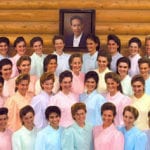 Our World
Our World  Our World
Our World  Pop Culture
Pop Culture 10 Incredible Female Comic Book Artists
 Crime
Crime 10 Terrifying Serial Killers from Centuries Ago
 Technology
Technology 10 Hilariously Over-Engineered Solutions to Simple Problems
 Miscellaneous
Miscellaneous 10 Ironic News Stories Straight out of an Alanis Morissette Song
 Politics
Politics 10 Lesser-Known Far-Right Groups of the 21st Century
 History
History Ten Revealing Facts about Daily Domestic Life in the Old West
 Weird Stuff
Weird Stuff 10 Everyday Products Surprisingly Made by Inmates
 Movies and TV
Movies and TV 10 Actors Dragged out of Retirement for One Key Role
 Creepy
Creepy 10 Lesser-Known Shapeshifter Legends from Around the World
 Our World
Our World 10 Science Facts That Will Change How You Look at the World
 Pop Culture
Pop Culture 10 Incredible Female Comic Book Artists
 Crime
Crime 10 Terrifying Serial Killers from Centuries Ago
Who's Behind Listverse?

Jamie Frater
Head Editor
Jamie founded Listverse due to an insatiable desire to share fascinating, obscure, and bizarre facts. He has been a guest speaker on numerous national radio and television stations and is a five time published author.
More About Us Technology
Technology 10 Hilariously Over-Engineered Solutions to Simple Problems
 Miscellaneous
Miscellaneous 10 Ironic News Stories Straight out of an Alanis Morissette Song
 Politics
Politics 10 Lesser-Known Far-Right Groups of the 21st Century
 History
History Ten Revealing Facts about Daily Domestic Life in the Old West
 Weird Stuff
Weird Stuff 10 Everyday Products Surprisingly Made by Inmates
 Movies and TV
Movies and TV 10 Actors Dragged out of Retirement for One Key Role
 Creepy
Creepy 10 Lesser-Known Shapeshifter Legends from Around the World
10 Bizarre Cult Teachings
The term “cult” already has a distinct stigma attached to it. They’re the people peacefully waiting for aliens to return in the best-case scenarios—and committing mass murders and suicide in the worst. Cults have existed for as long as recorded history, and while they all seem a little odd on the surface, dig past their mission statements and you might be rewarded with some cult teachings and doctrines that go well into the extra-weird.
SEE ALSO: 10 Shocking Facts Of The World’s Most Dangerous Cult
10 Ritual Hanging In Ancient Greece

Dionysus has the reputation of being the Olympian that would be the most fun to hang out with on a Friday night. God of wine and fertility, he had a massive following across ancient Greece. While most of his festivals were of the “let’s parade giant phallic symbols through the street and drink jugs of wine” sort, the Anthesteria Festival of Athens celebrated a very different aspect of the Dionysus myth.
According to legend, Icarius was taught the art of wine making by Dionysus himself. Icarius shared his knowledge with his fellow shepherds, who proceeded to get drunk. Believing that Icarius had poisoned them, they killed him. When his faithful dog, Maera, led his daughter Erigone (also known as Aletis) to his grave, she hung herself in despair.
The first two days of Anthesteria are pretty typical—sacrifices of fruits and rams were given to honor the murdered Icarius and his daughter. But on the third day, women called Aletides hung themselves (non-lethally) from ropes tied to wooden beams so their bodies swung in the wind. A solemn ceremony, it was performed in public and in private, in remembrance of Erigone’s suicide.
It’s said that after the deaths of Icarius and Erigone, Dionysus had all other daughters of Athenians hanged in retribution; the ritual hanging of the Aletides was in hopes of avoiding Dionysus’s further wrath.
9 Raelism And Sex Workers

The Raelian Movement was founded in 1973 by racecar driver turned prophet Claude Vorilhon, after a humanoid figure descended in a UFO to tell him that the alien scientists who created human DNA were planning on returning. (The Raelian slogan is “Intelligent Design for Atheists.”) He changed his name to Rael and started raising funds to build an extraterrestrial embassy. Chief among Raelian values is the idea that the human body is a work of art, and should be celebrated as the scientific miracle that it is.
Within Raelism is a women-only sect called Rael’s Girls. This group of women not only celebrate the feminine and open sexuality, but prominently stand in support of those who honor Rael’s teachings by bringing pleasure to the world via prostitution or other employment in the sex industry. They encourage women who work in the sex industry to be proud of their occupation, one that brings pleasure and enlightenment to so many.
They stress that there is no need to be ashamed in deciding to be a stripper or a prostitute, or visiting such open-minded and free-spirited women. They say the work and mission of those in the sex industry is to promote non-violence and a higher understanding of psychological needs . . . through being paid for sex.
8 The Inside-Out Universe

The idea of a hollow Earth isn’t anything new—even astronomer Edmund Halley played around with the idea in the 17th century. But eclectic medicine proponent and alchemist Cyrus Teed Reed took the theory a bit further in the 1860s.
Teed Reed received a vision from “The Divine Motherhood,” telling him that he was, in fact, the “New Messiah” and that everything he had suspected about cosmology was true. The Divine Motherhood confirmed that, not only is the Earth hollow, we are living on the inside of it. The Earth is in fact a bubble of air within solid rock, and we are all walking on the interior surface of it. The sky above us is actually in the center of the hollow ball, and the sun is at the absolute center of that. He spent the rest of his life trying to unite science and religion on that theory.
He took the Hebrew version of his given name—Koresh—and started The Koreshan Unity Foundation in Chicago. While preaching celibacy and science to his small community, Teed and his followers set up a number of scientific experiments measuring light refraction and curvature of water surfaces to support his claims. The Koreshan Unity Foundation developed a very complex Cellular Cosmogony theory that included the bending of light rays, layers of the earth, and atmospheric turbulence and irregularities as reasons for numbers that might not quite work and—most intriguingly—why we can’t see the people walking on the inside of the dome across from us.
7 The Harrowing Easter Island Egg Hunt
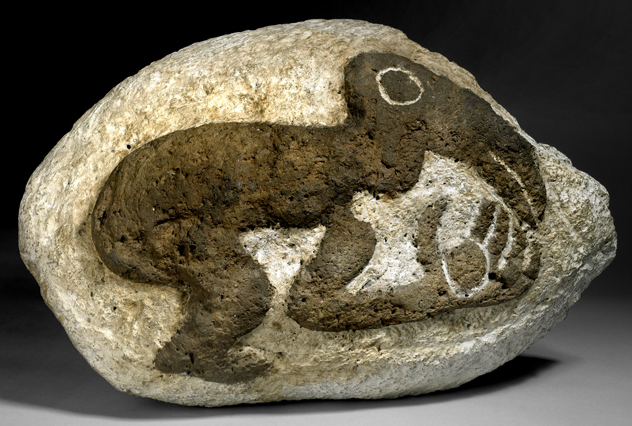
The birdman cult of Orongo, Easter Island, has taken the idea of having your minions do your dirty work to a whole new level. Power on the island was long controlled by a warrior class called the “matatoa,” and every year the various leaders of the class competed to see who was going to be rewarded with the title of birdman—which means exactly what it sounds like, half-man, half-bird—for the year, and enjoy the benefits of being treated like a god.
Each potential warrior leader selected a champion, who then descended a sheer cliff face 300 vertical meters (1,000 ft) to the shark-infested ocean waters below. They swam to the nearby island of Motu Nui, home and nesting grounds of the sooty tern. Once they got an egg from a bird’s nest, they had to make the return journey across the ocean and up the cliff without breaking it. The first man to return with an unbroken egg would receive to the honor of having his sponsor crowned birdman for the year.
6 The Externsteine Stones And Nazi Occultism
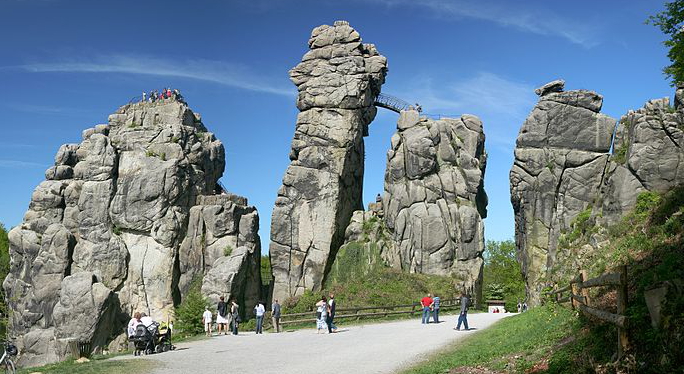
Externsteine, or the stones of Egge, are a massively impressive group of five naturally formed standing stones in northern Germany. Prior to the arrival of Christian monks in the late 700s, the stones seem to have been used for utilitarian purposes such as shelter from the elements. When the monks settled there, they carved the first stairs into the rocks, launching the site on its journey from utilitarian to magical.
The site changed ownership several times before ending up in the hands of the Nazi Party’s head occultist, Heinrich Himmler. Himmler was the founder of a Nazi research organization called Ahnenerbe. The Ahnenerbe’s official mission was to find and publicize historical records and artifacts supporting the age-old accomplishments of the Aryan race.
What they really did was take existing archaeological sites and fabricate a pro-Nazi mythos around them—and Externsteine was a prime candidate. Centuries-old carvings were re-interpreted to have Aryan roots, and a glorious, Teutonic history was “discovered” at the limestone pillars. Externsteine became known as a natural monument to the glory of German nationalism. The Nazi propaganda machine created so much false history around the site that much of the original, real history has been lost. So much so that neo-Nazis now gather there alongside neo-pagans during the summer solstice.
5 Paschal Beverly Randolph And Sex Magic
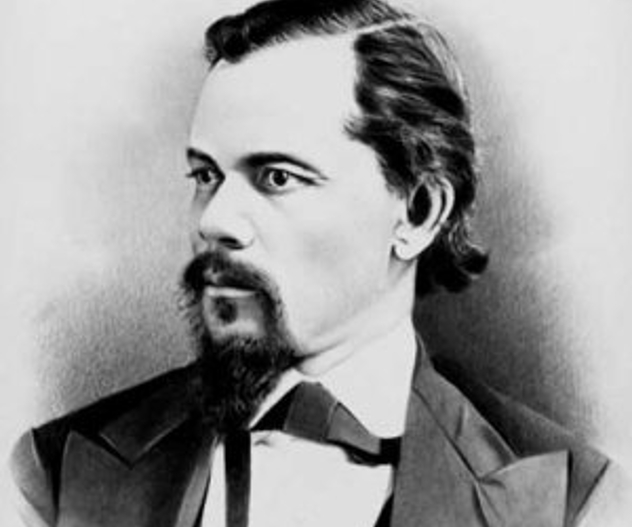
Paschal Beverly Randolph was a world traveler who brought the Fraternitas Rosae Crucis to the western world—specifically, to San Francisco. Going on a world tour through countries from England and Scotland to Palestine and Malta, Randolph collected a wide range of philosophies, research, studies, and secret teachings from vast numbers of secret societies and groups. These he compiled into books, one of which outlined perhaps the most important of his beliefs (not necessarily the order’s, although he did undoubtedly use his connections to get inside information and interviews): sex magic.
The basis of his book Magia Sexualis is that the male has a positive charge, the female has a negative charge, and when they are properly applied to each other, they recharge each other. Randolph outlines a number of guidelines on how to properly perform sex magic, including choosing a partner of equal social standing (base women are right out), not sharing your magical intentions with your partner, keeping a vivid mental picture of your magical goals, and taking care to have proper hygiene.
“Proper hygiene” includes selecting appropriate items from a list of substances (such as gelatin, the coal of a poplar tree, extract of chamomile, lactose, and brass powder) and applying to an object to increase its “talismanic virtues.” In a refreshing twist for a cultist, he also specifies that partners should both be over the age of 18, so the proper solemnity of the act can be embraced with a mature attitude.
4The Opening Of The Mouth Ritual
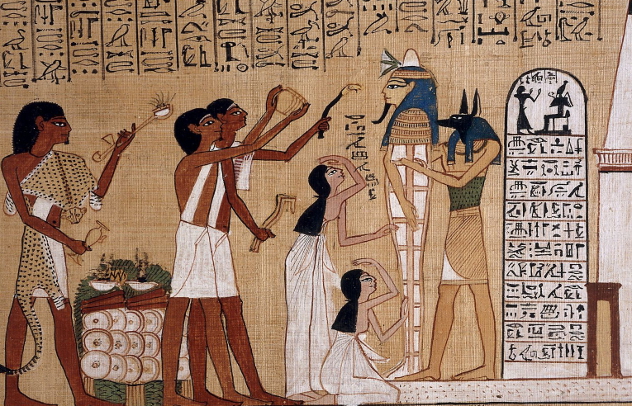
In ancient Egypt, passing through the lands of the living and of the dead was a very serious business. Goddesses like Nekhbet and Wedjat were thought to give the dead “life and dominion,” guiding them to their new life on the other side. While not a cult teaching in the typical sense of the word, the ceremonies revolving around the Opening of the Mouth Ritual were very specialized and very sacred. And not a little strange.
In order to be reborn in the afterlife, the body of the deceased must be properly prepared—and that means opening their eyes and mouth so they can breathe, see and eat in the next world. Tableaux on the walls of tombs and burial chambers have given us a clear picture of how and why the ritual is performed.
First, an ox is ritualistically slaughtered and the foreleg is removed. The severed leg is then used to touch the mouth and eyes of the dead, opening them, and so reviving the person for their journey to the afterlife. A funeral meal is then prepared, and is presented to the deceased with a variety of other offerings that befit the station they held in their earthly life.
3 Kybele And Self-Castration
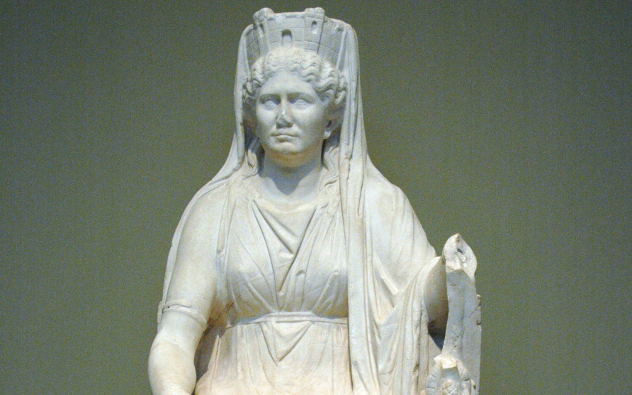
Kybele was the Phrygian goddess of fertility and nature; when she was introduced to Greece, she became the mother of Dionysus. Her original Phrygian festivals were known as the Orgiastic festivals, and were full of dancing, music-making, and drinking. Young men performed intricate, armed war dances to music and traditional songs. Traditional songs and traditional self-mutilation.
The dancing and celebration built the excitement to such a level that many worshipers escalated to flagellation; texts refer to devotees beating themselves with leather thongs. The most devout of all castrated themselves amidst the festivals and rituals; these Gallai priests were the sacred of Kybele, and their initiation rites and rituals were a closely guarded secret. Some texts suggest that even after the priests castrated themselves, they continued to cut themselves more during future festivals and anoint festival decorations with their blood.
2 The Cult Of Relics And Sacred Breast Milk
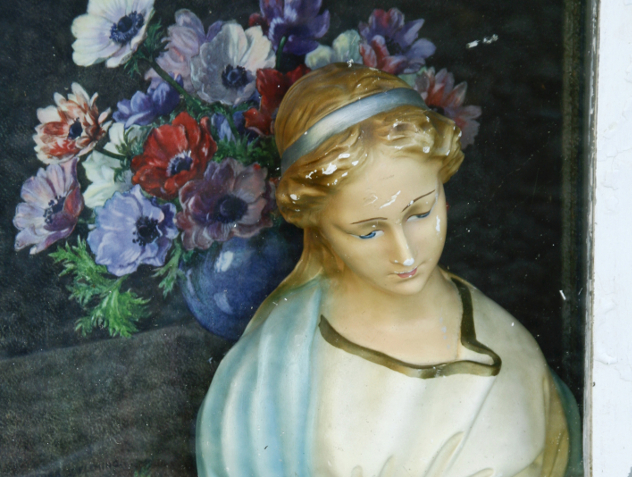
Christianity and capitalism aren’t necessarily mutually exclusive, and the cult of relics is a stark reminder of that. Somewhere around 820, Venetian merchants made the discovery that people will pay good money to own a piece of a person who has lived a holy life. Not long after, they discovered that people would pay just as much for recently manufactured relics as they would for items actually associated with holy persons.
Sometimes, relics were what they were supposed to be—an actual part of a person, like a bone, a tooth, a patch of skin. Perhaps even more unsettling than the collection of these relics is the attributes given to them. Religious writings from the Middle Ages refer to the character traits of the bones or full skeletons. Saints’ bones were intelligent, serene, and gave those nearby a peaceful feeling, but some of them were also high maintenance. It wasn’t unheard of for preserved corpses to get a haircut centuries after their deaths, or have a few teeth pulled (coincidentally resulting in more relics to sell.)
An exhibit at the British Museum has a variety of relics on display, proving that there’s no end to the odd items once deemed holy by the cult of relics. Sacred relics on record include a sample of the Virgin Mary’s hair and breast milk, a clear vial that contains the breath of Christ, and the Archangel Gabriel’s definitely-for-real feathers.
1Elevating Emperors To Gods
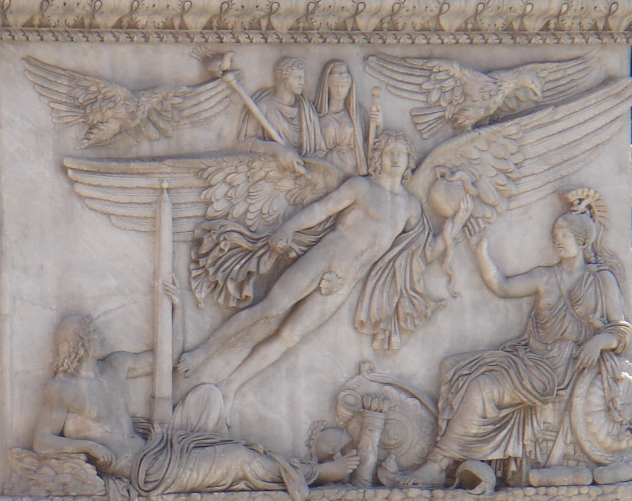
The worship of rulers as divine beings is hardly uncommon, but the Romans made it a state religion. The Imperial Cult was devoted to the worship of dead emperors as gods. Temples were built to honor them, complete with mosaics depicting them being raised into the heavens to take their rightful place as gods. Julius Caesar was the first to be officially recognized as divine.
The cult was as much a political move as it was a religious move. The Roman empire was huge, and it allowed “priests” to easily spread the propaganda of the emperor being an all-powerful entity. In many areas, the Imperial Cult existed alongside Christianity; there were differences between being a state god and a religious god. During the reign of Augustus, membership in the Imperial Cult meant an increase in status. Not only were landowners and freemen wealthy enough to support the cult—and Rome—but they were also eligible for appointments to the lucrative cult priesthood.

